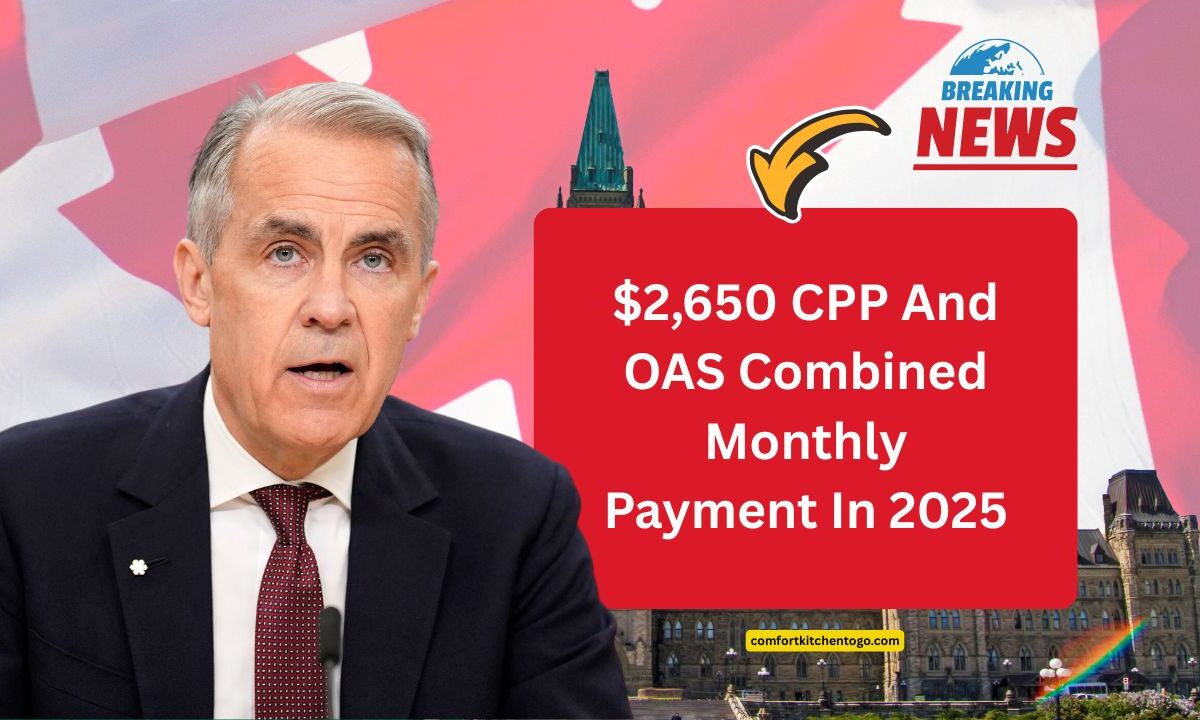Many Canadians are curious whether they can actually receive up to $2,650 per month from CPP and OAS in 2025.
The answer is yes—but it depends on your contribution history, age, and residency in Canada. In some cases, low-income retirees may even exceed that figure with the help of Guaranteed Income Supplement (GIS).
Here’s everything you need to know to find out if you qualify and how to boost your payments.
Understanding the Breakdown: CPP + OAS in 2025
| Feature | Details (2025) |
|---|---|
| Maximum CPP (Age 65) | $1,433.00/month |
| Maximum OAS (Age 65–74) | $727.67/month |
| Maximum OAS (Age 75+) | $800.44/month |
| Combined Max (65–74) | $2,160.67/month |
| With GIS (Low-Income) | Up to $3,247.55/month |
| Eligibility Age | 65+ |
| OAS Full Residency Needed | 40 years after age 18 in Canada |
| GIS Income Threshold (Single) | Below $22,056 annually |
What Is the Canada Pension Plan (CPP)?
CPP is a work-based retirement benefit funded by your payroll contributions. Your monthly payout depends on how much and how long you contributed.
- Maximum Canada Pension Plan (age 65): $1,433/month
- Average Canada Pension Plan in 2025: $758.32/month
- To get max: You must contribute the maximum for about 39 years
- Self-employed individuals pay both portions of the contribution
What Is Old Age Security (OAS)?
Unlike Canada Pension Plan, OAS is based on your residency in Canada, not your employment history.
- Ages 65–74: Up to $727.67/month
- Ages 75+: Up to $800.44/month
- You must live in Canada for at least 10 years after age 18 for partial OAS
- 40 years of residency = Full OAS
OAS is indexed quarterly for inflation, offering some protection against rising living costs.
How to Maximize Your Monthly Payments
1. Maximize Your Canada Pension Plan Contributions
To get the full $1,433/month:
- Work and contribute for ~39 years at the maximum pensionable earnings
- Dropout provisions allow low-earning years to be excluded
- Self-employed? Stay up-to-date on your contributions
2. Build Your OAS Residency Record
- 40 years in Canada = full OAS
- 10–39 years = partial payment
- Time spent abroad may still count under international social security agreements
3. Add GIS if You’re Low-Income
GIS provides non-taxable income support:
- Singles: Up to $1,086.88/month
- Couples: Up to $654.23/month each
- Eligibility depends on annual income:
- Singles: Below $22,056
- Couples: Below $29,136 combined
GIS can boost total monthly income over $3,200.
Real-Life Examples
Linda (Age 67 – Retired Teacher)
- 40 years of full CPP contributions
- Full Canadian residency
- CPP: $1,433
- OAS: $727.67
- Total: $2,160.67
She does not qualify for GIS due to pension income but enjoys a stable retirement.
George (Age 75 – Semi-Retired)
- 30 years of CPP contributions
- Worked abroad for 5 years
- CPP: $1,200
- OAS: $800.44
- GIS: $600
- Total: $2,600.44
GIS closes the income gap due to limited CPP and OAS.
Extra Tips for Bigger Payments
- Delay CPP to age 70: Increases benefits by 42%
- Delay OAS to age 70: Increases benefits by 36%
- Apply 6 months in advance to avoid delays
- Track your records via the My Service Canada Account
- Consider Provincial Supplements like GAINS (Ontario)
If you’re planning for retirement in Canada, understanding the mechanics of CPP, OAS, and GIS can make a significant difference in your monthly income.
With smart planning and early contributions, many seniors in 2025 are already receiving up to $2,650/month or more.
Start reviewing your records now to ensure you’re getting the maximum benefits available to you.
FAQs
Can I still get OAS if I haven’t worked in Canada?
Yes. OAS is based on residency, not work history. You can qualify with at least 10 years of Canadian residency after age 18.
Is GIS added automatically with OAS?
No. You must apply separately for GIS, even if you qualify for OAS. Income must be below set limits.
What if I delay receiving CPP or OAS?
Delaying CPP until age 70 can boost your payments by up to 42%, and OAS by up to 36%, leading to higher monthly income.
